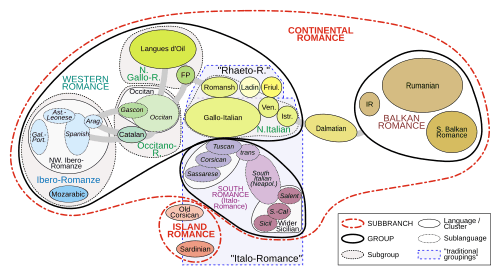Italo-Western languages
Italo-Western is, in some classifications, the largest branch of the Romance languages. It comprises two of the branches of Romance languages: Italo-Dalmatian and Western Romance. It excludes the Sardinian language and Eastern Romance.
| Italo-Western | |
|---|---|
| Geographic distribution | Italic Peninsula, France, Iberia (Spain and Portugal) |
| Linguistic classification | Indo-European |
| Subdivisions | |
| Glottolog | ital1285[1] |
 | |
Italo-Dalmatian languages
Based on mutual intelligibility, Dalby lists four languages: Corsican, Tuscan and Italian, Napolitan–Sicilian, and Dalmatian.[2]
Dalmatian Romance
- The Dalmatian language was spoken in the Dalmatia region of Croatia. It became extinct in the 19th century.
- The Istriot, spoken on the Istrian peninsula of Croatia, Slovenia, and Italy.
Tuscan and Italian
- The Tuscan language is mainly spoken in Tuscany, Italy.
- The Corsican language is related to Tuscan and has the dialects of Gallurese and Sassarese.
- The Italian language, is the closest to Latin of the Romance languages.[3] Italian is an official language in Italy, Switzerland, San Marino, Vatican City and western Istria (in Slovenia and Croatia). It used to have official status in Albania, Malta and Monaco, where it is still widely spoken, as well as in former Italian East Africa and Italian North Africa regions where it plays a significant role in various sectors. Italian is also spoken by large expatriate communities in the Americas and Australia. Italian has been primarily based on Tuscan, specifically on its Florentine variety and later deeply influenced by almost all regional languages of Italy while its received pronunciation (known as Pronuncia Fiorentina Emendata, Amended Florentine Pronunciation) is based on the accent of Romanesco (Roman dialect); these are the reasons why Italian differs significantly from Tuscan.[4]
Central Italian
- The Central Italian languages, or Latin-Umbrian-Marchegian, include the varieties of Romanesco and Marchigiano.
Southern Italian
- Neapolitan language is spoken in Southern Italy.
- The Italian of the Far South:
- The Sicilian language is spoken in Sicily; central and southern Calabria; in Roccagloriosa and Rofrano; and in the Salento peninsula of southern Apulia.
Western Romance languages
Based on mutual intelligibility, Dalby lists a dozen languages: Portuguese, Spanish, Asturian-Leonese, Aragonese, Catalan, Gascon, Provençal, Gallo-Wallon, French, Franco-Provençal, Romansh, and Ladin.[2]
Gallo-Romance
Gallo-Romance includes:
- The Langues d'oïl, or Oïl languages. These include Standard French, Picard, Walloon, Lorrain and Norman.
- The Arpitan language, also known as Franco-Provençal. It shares features of both French and the Provençal dialect of Occitan. Sometimes included in the Oïl languages.
Gallo-Romance can include:
- The Rhaeto-Romance languages. They include Romansh of Switzerland, Ladin of the Dolomites area, Friulian of Friuli. Rhaeto-Romance languages can be classified as Gallo-Romance, or as an independent branch of the Western Romance languages.
- The Occitano-Romance languages of Southern France and East Iberia, includes Occitan and Catalan. Occitano-Romance languages can be classified as Gallo-Romance, Iberian-Romance, or as an independent branch of the Western Romance languages.
- The Occitan language, or langue d'oc, has dialects such as Provençal dialect, and Gascon-Aranese dialect.
- The Catalan language has standard forms of Catalan and Valencian. Can be classified as East Iberian.
- The Gallo-Italic languages. They include Piedmontese, Ligurian, Lombard, Emiliano-Romagnolo, Gallo-Italic of Sicily and Gallo-Italic of Basilicata. Gallo-Italic languages can be classified as Gallo-Romance or as Northern Italian dialects. The Venetian language is sometimes included in Gallo-Italic, but it has several characteristics that set it apart from it.[5]
The Oïl languages, Arpitan and Rhaeto-Romance languages are sometimes called Gallo-Rhaetian.
Iberian-Romance
- The West Iberian languages:
- The Castilian languages: includes Spanish and Judaeo-Spanish.
- The Galician-Portuguese languages: includes Portuguese, Galician, Fala and Uruguayan Portuñol.
- The Astur-Leonese languages: they are, from east to west, Cantabrian, central-eastern Asturian and Leonese proper. Going from north to south, they are Leonese proper, Mirandese, Extremaduran and Barranquenho.
- The Pyrenean–Mozarabic languages: includes Aragonese, and the extinct Mozarabic. Can be classified as West Iberian.
- The East Iberian language, or Catalan language: usually classified as part of Occitano-Romance, see Gallo-Romance above.
gollark: Folders seem useless, I don't want private or unlisted pastes, scraping would be cool but not worth £50.
gollark: What's it good for?
gollark: `pastebin_osmarks_20191228.tar.zst`
gollark: I've got a backup from a while ago in case it randomly implodes at least!
gollark: I use Pastebin for basically all my stuff, but still use their free plan.
References
- Hammarström, Harald; Forkel, Robert; Haspelmath, Martin, eds. (2017). "Italo–Western Romance". Glottolog 3.0. Jena, Germany: Max Planck Institute for the Science of Human History.
- David Dalby, 1999/2000, The Linguasphere register of the world's languages and speech communities. Observatoire Linguistique, Linguasphere Press. Volume 2. Oxford. Archived 2014-08-27 at the Wayback Machine
- "Romance languages". Encyclopædia Britannica. Retrieved 19 February 2017.
... if the Romance languages are compared with Latin, it is seen that by most measures Sardinian and Italian are least differentiated and French most
- La pronuncia italiana (Italian). treccani.it
- Lorenzo Renzi, Nuova introduzione alla filologia romanza, Bologna, Il Mulino, 1994, p. 176 «I dialetti settentrionali formano un blocco abbastanza compatto con molti tratti comuni che li accostano, oltre che tra loro, qualche volta anche alla parlate cosiddette ladine e alle lingue galloromanze [...] Alcuni fenomeni morfologici innovativi sono pure abbastanza largamente comuni, come la doppia serie pronominale soggetto (non sempre in tutte le persone)[...] Ma più spesso il veneto si distacca dal gruppo, lasciando così da una parte tutti gli altri dialetti, detti gallo-italici.»
This article is issued from Wikipedia. The text is licensed under Creative Commons - Attribution - Sharealike. Additional terms may apply for the media files.